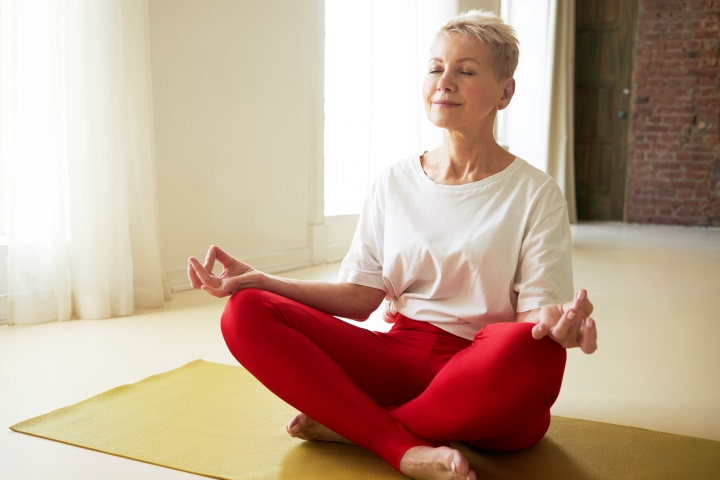In menopause and the transition phase, getting stressed at the drop of a hat isn’t uncommon. Don’t blame yourself, and feel guilty if your anxiety levels are way too high when you are in your mid-40s. With so much on the physical front, it could sometimes become mentally and emotionally taxing. Being stressed is normal, but you should consciously look for ways to manage your anxiety.
Our team recently contacted Mrs. Sabrina Johnson for her insight on relaxation techniques for menopause. Mrs. Johnson has expertise in the field of obstetrics and gynecology. Her immense knowledge and appealing writing have made her reach to many women whom she vouches to guide in their journey of menopause. Let’s look at what Mrs. Johnson says about relaxation in menopause.
Q. Why Do Women Get Anxious In Menopause?
A: When your hormone levels, estrogen, go haywire, it affects your body big time. It impacts your mood as well. Let’s get to understand some science here. The neurotransmitters or chemical messengers transmit signals from the brain’s nerve cells to the remaining parts of your body.
Some of the neurotransmitters like dopamine, cortisol, and serotonin are linked with your overall well-being, anxiety levels, and stress. The role of estrogen is significant in producing and regulating these neurotransmitters. So, a dip in estrogen levels results in an alteration in the levels of these neurotransmitters.
For example, low estrogen levels lower serotonin activity, which is instrumental in controlling one’s mood. Low serotonin levels account for the mood swings women often face in menopause. On the other hand, when estrogen levels decline, cortisol levels rise. Raised cortisol levels mean high stress.
There’s a lot to understand beyond this science as well. Because of the fluctuating hormone levels, women face bothersome signs like night sweats, hot flashes, sleep disruption, and much more. These could take a toll on a woman’s mood, making them irritable, anxious, and stressed.
A study conducted on 300 women revealed that the prevalence of stress was more significant in perimenopausal (46.5%) and post-menopausal (85.3%) women than in their premenopausal (19.7%) counterparts.
Did you know? About four of ten women have mood fluctuations in the perimenopause phase, which replicate PMS (premenstrual syndrome).
Q. What Are The Different Breathing Techniques To Relax In Menopause?
A: When it comes to relaxing in menopause, I would say that take it easy on yourself. Do things that you enjoy the most. Give yourself ample ‘me time’. If you desire some relaxation, it is essential you try some deep breathing exercises. For that, you’ve got to have the correct ambiance, devoid of distractions. You should also clear away any distractions and worries while trying relaxation techniques. Here are some breathing exercises to consider.
- Rhythmic Breathing – It will help those with short, hurried breaths. You need to inhale slowly to a count of five. Then, exhale slowly by counting five again. This will help your body relax eventually.
- Visualized Breathing – You must find a place in your home that comforts you. Once that is done, shut your eyes and imagine how you are breathing. Visualize that the breath is reaching your nostrils, entering your lungs, and expanding your chest. You should also imagine that your breath is being exhaled similarly. When you can get it right, you will feel more relaxed.
- Deep Breathing -First, you’d have to visualize an imaginary spot below the navel. Inhale into that particular spot. When you do so, fill your abdomen with sufficient air. Then, exhale in a way as if a balloon is getting deflated. When you exhale slowly for a long time, you’ll feel more relaxed and at peace with yourself.
- 4-7-8 Breathing Method – This is a unique breathing pattern apt for individuals with increased anxiety levels and sleep issues. Inhale through your nose for four seconds. Hold your breath for around seven seconds. Then, exhale through your mouth forcefully for approximately eight seconds.
- Focus Word Breathing Technique – This is another interesting breathing technique. Select a focus word that comforts and relaxes you. It can be anything like ‘Take it easy”, ‘Slow down,” ‘Smile,” etc. You need to keep repeating the word during the session. To do this, you must sit or recline in your comfort zone.
Fluctuate between normal and deep breathing. Each time you breathe deeply to a count of three, say your word aloud or think of it. Your focus should only be on that word and the air you inhale. If you imagine the inhaled air fills your mind with tranquility, you’ll feel better. You could also replace the focus word with visual imagery. You can think of any beautiful or picturesque scene. It could be a mountain, meadow, beach, or anything fascinating.
Q. What Are The Other Ways To Relax During Menopause?
A: Besides the breathing techniques mentioned above, you can relax by doing activities that give you comfort and joy. If music interests you, you can listen to something soft and soothing to calm your mind. Sometimes, even small things like taking a walk in the park or chatting with friends over coffee give us relief. I would even suggest exploring your creative side.
Like, I had a fascination for dance and desired to join a zumba class pretty late in my mid-40s to ease my stress. I felt great and got to meet like-minded ladies who were coping to manage their anxiety levels. It was a good feeling to talk to them and share thoughts. You can even enroll in a yoga class or arrange massage sessions. All of these will surely help you feel better.
Q. How Does Massage Help To Manage Menopause-Related Stress?
A: Irrespective of whether you are in menopause or not, massage helps to cope with stress significantly. Most women in menopause have preferred a Swedish massage since it helps to ease stress and relax.
If it’s a full-body massage, the therapist massages your back first. She eventually proceeds to the arms, hands, legs, and sometimes feet.
Swedish massage can even include a relaxing head massage. Swedish massage is helpful in many ways since it helps to manage stress, increases blood flow, lessens stress, boosts immunity, and enhances the flexibility of muscles. Aromatherapy is also beneficial for boosting a woman’s overall well-being. The only difference is that aromatherapy uses essential oils, which Swedish massage doesn’t.
Conclusion
Mrs. Johnson, in conclusion, even said, “Hey lovely ladies, I hope my inputs on relaxation in menopause would help. To know more about me or for any assistance, kindly get in touch”. While ending, she added that women must also be cautious of what they eat. A balanced diet of fruits, veggies, and essential carbs will boost your mental health.
She also advised against stress eating as that could do more harm than good, aggravating some of your menopausal symptoms.
If managing stress in menopause gets overwhelming, leading to a mental breakdown, do not delay in seeking medical help.
Resources:
https://pubmed.ncbi.nlm.nih.gov/25039019/
https://www.ncbi.nlm.nih.gov/pmc/articles/PMC6052783/













